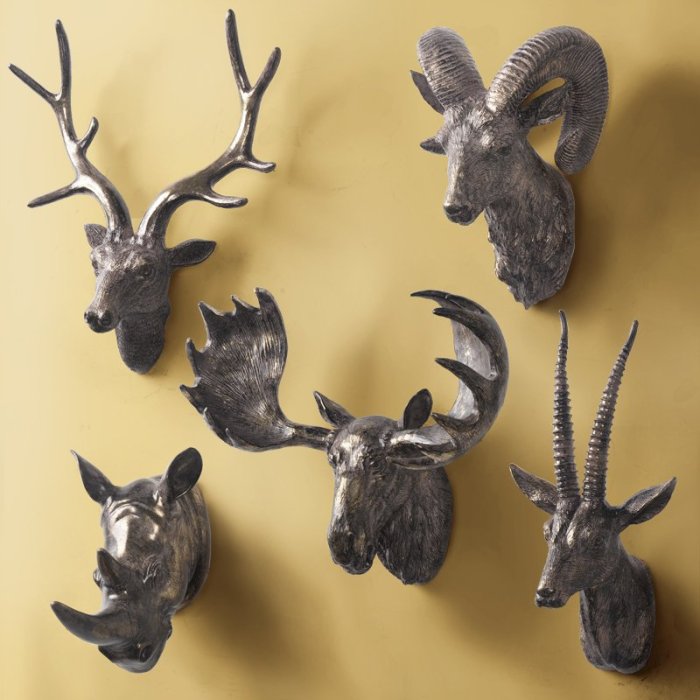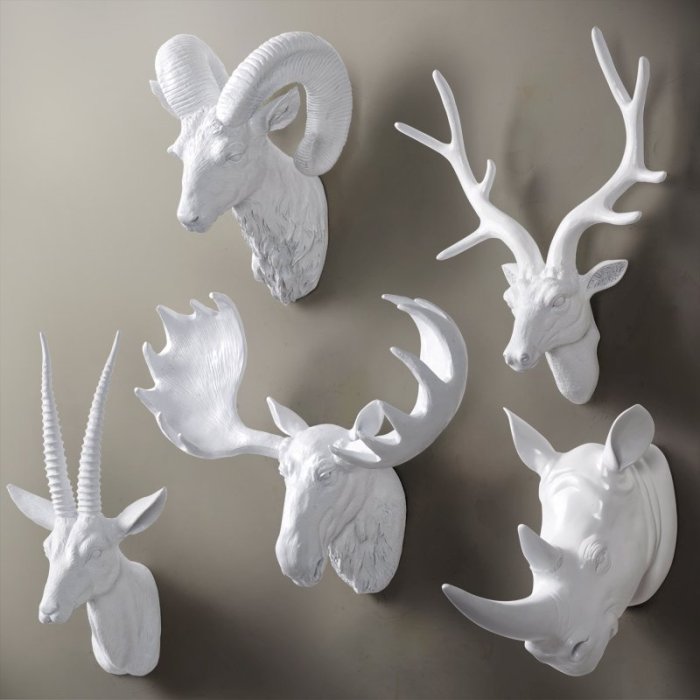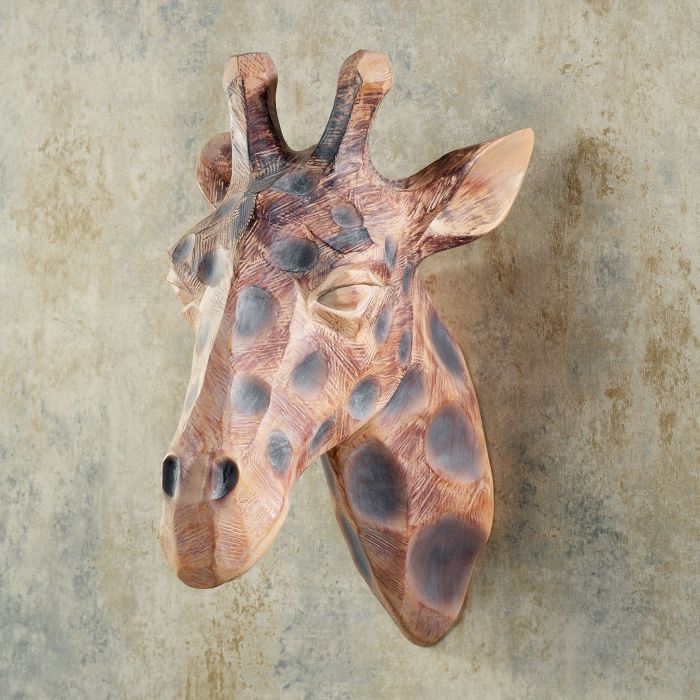Animal Head Wall Decor: Transforming ordinary spaces into captivating havens of style and personality is easier than you think. This guide delves into the fascinating world of animal head wall decor, exploring its diverse styles, materials, and the impact it can have on your home’s aesthetic. From the rustic charm of a weathered wooden deer head to the sleek modernity of a minimalist metal fox, we uncover the artistry and craftsmanship behind these unique pieces.
We’ll examine the current market trends, explore ethical considerations, and offer practical advice on incorporating animal head wall decor into your own living space.
We’ll cover everything from the manufacturing processes and materials used to create these striking pieces to the various design styles and how to best incorporate them into different room settings. Learn how to choose the perfect animal head to complement your existing décor, and discover the power of lighting to enhance their visual impact. Whether you’re a seasoned interior design enthusiast or simply looking to add a touch of unique character to your home, this comprehensive guide will provide the insights and inspiration you need.
Market Overview of Animal Head Wall Decor

The animal head wall decor market showcases a dynamic blend of traditional craftsmanship and modern design aesthetics, appealing to a broad spectrum of consumers seeking unique and expressive home decor. This market segment is experiencing growth fueled by evolving interior design trends and a rising demand for personalized home environments.
Current Trends in Animal Head Wall Decor
Current trends indicate a shift towards more stylized and abstract representations of animal heads, moving away from strictly realistic depictions. Sustainable and ethically sourced materials are gaining popularity, reflecting a growing consumer consciousness regarding environmental and animal welfare issues. The use of metallic finishes, such as gold and silver, adds a touch of luxury and modern sophistication, while incorporating natural textures like wood and stone provides a rustic or bohemian feel.
Furthermore, the integration of animal head decor into eclectic and maximalist design schemes is becoming increasingly prevalent.
Popular Animal Types
Deer, elk, and buffalo heads remain consistently popular choices, owing to their classic appeal and association with rustic and outdoorsy aesthetics. However, a growing trend encompasses a wider range of animals, including foxes, wolves, rams, and even more exotic species, reflecting a broader range of tastes and stylistic preferences. The selection often depends on the overall design theme of the space, with certain animals lending themselves better to specific styles (e.g., a whimsical fox head for a playful children’s room, a majestic elk head for a lodge-style living room).
Price Ranges Based on Materials and Styles
Price points vary considerably depending on the materials used and the level of craftsmanship involved. Realistic animal heads crafted from high-quality taxidermy can range from several hundred to several thousand dollars, depending on the animal and the artist’s reputation. Faux taxidermy, utilizing materials like resin, wood, or metal, offers a more affordable alternative, typically ranging from $50 to $500, with price variations depending on size, complexity, and materials.
Minimalist designs, often made from simpler materials, tend to be on the lower end of the price spectrum.
Target Demographic, Animal Head Wall Decor
The target demographic for animal head wall decor is diverse, encompassing homeowners with a range of ages, styles, and income levels. However, the market shows a strong appeal to individuals and families who appreciate unique and statement-making home decor. This includes those with interests in hunting, nature, rustic or bohemian design styles, and those seeking to add a touch of personality and individuality to their living spaces.
Younger homeowners, particularly millennials and Gen Z, are driving the demand for more modern and stylized designs.
Styles of Animal Head Wall Decor
Animal head wall decor can be broadly categorized into several styles. Realistic representations aim for a lifelike depiction of the animal, often employing high-quality taxidermy or exceptionally detailed faux taxidermy. Stylized designs feature artistic interpretations of animal heads, often simplifying or abstracting features to create a more modern or whimsical look. Minimalist styles prioritize simplicity and clean lines, using basic shapes and muted colors to create a subtle yet impactful statement.
Other styles may incorporate specific design themes, such as vintage, industrial, or eclectic, to suit a particular interior design scheme.
Materials and Manufacturing Processes

Animal head wall décor encompasses a diverse range of materials and manufacturing techniques, each impacting the final product’s aesthetic, durability, cost, and environmental footprint. Understanding these processes is crucial for both consumers seeking specific qualities and manufacturers aiming for sustainability and ethical practices.
Materials Used in Animal Head Wall Décor
A variety of materials are employed in the creation of animal head wall décor, each offering unique advantages and disadvantages. Common materials include wood, resin, metal, and taxidermied animals. Wood offers a natural and often rustic aesthetic, while resin allows for intricate detail and a wide range of colors and finishes. Metal provides a modern and durable option, and taxidermy utilizes preserved animal remains to create a realistic representation.
The choice of material significantly influences the manufacturing process and the final product’s characteristics.
Manufacturing Process: Wood
The creation of a wooden animal head begins with selecting a suitable wood type, such as oak or pine, known for their strength and workability. A skilled craftsman then carves the chosen wood, often using CNC milling machines for precision and efficiency in mass production, or hand tools for a more bespoke and artisan approach. The carving process involves shaping the wood to resemble an animal’s head, paying close attention to anatomical details.
Once carved, the piece is sanded smooth and may be treated with a protective sealant or stain to enhance its durability and appearance. Finally, it is often mounted on a backing for wall display. Smaller-scale productions might utilize simpler carving techniques, possibly focusing on stylized representations rather than photorealistic accuracy.
Manufacturing Process: Resin
Resin animal heads begin with a mold, typically created using 3D printing or traditional sculpting techniques. This mold serves as the template for the resin casting process. The resin, often a polyurethane or epoxy resin, is mixed with a hardener according to the manufacturer’s instructions and carefully poured into the mold. Air bubbles are removed to ensure a smooth, flawless finish.
The mold is then left to cure, a process that can take several hours or even days, depending on the resin type and environmental conditions. Once cured, the resin casting is removed from the mold, and any imperfections are carefully sanded and finished. The piece is then painted and detailed to achieve the desired aesthetic, potentially incorporating metallic pigments or other decorative elements.
Environmental Impact of Different Materials
The environmental impact varies significantly depending on the material used. Wood sourced from sustainably managed forests has a relatively low impact, especially compared to the intensive resource use associated with metal production. Resin production involves the use of chemicals, posing potential environmental concerns related to manufacturing processes and disposal. Taxidermy raises significant ethical and environmental issues due to the use of animal remains, and the sustainability of the sourcing practices is paramount.
Sustainable sourcing and responsible manufacturing practices are crucial to minimize the environmental footprint of animal head wall décor.
Ethical Considerations
The ethical implications of using certain materials, particularly taxidermy, are significant. The sourcing of animals for taxidermy must adhere to strict regulations to ensure the animals were not illegally hunted or poached. Consumers should prioritize ethically sourced taxidermy, supporting businesses that demonstrate responsible and transparent sourcing practices. Alternatively, opting for alternative materials, such as wood or resin, avoids the ethical concerns associated with using animal remains.
Material Comparison Table
| Material | Durability | Cost | Aesthetic Qualities |
|---|---|---|---|
| Wood | High (depending on wood type and finish) | Medium to High | Natural, rustic, versatile |
| Resin | Medium to High | Medium | Highly detailed, customizable, wide range of colors and finishes |
| Metal | Very High | High | Modern, sleek, durable |
| Taxidermy | High (with proper preservation) | High to Very High | Realistic, natural, unique |
Consumer Perception and Trends

The market for animal head wall decor is driven by a complex interplay of factors influencing consumer purchasing decisions. Understanding these influences, particularly across different demographics and lifestyle preferences, is crucial for businesses operating within this niche. This section analyzes consumer perception and trends, highlighting key drivers of purchase decisions and the evolving nature of this market segment.
Factors Influencing Purchase Decisions
Several factors significantly impact a consumer’s decision to purchase animal head wall decor. These include aesthetic appeal, perceived value, material quality, ethical considerations, and the overall style of the home. For instance, the realism of the piece, the size and scale, and the specific animal depicted all contribute to its visual attractiveness. The price point, relative to perceived quality and craftsmanship, is another major factor.
Consumers increasingly scrutinize the materials used, favoring sustainable and ethically sourced options. Finally, the overall design must align with the homeowner’s existing interior style, be it rustic, modern, bohemian, or eclectic.
Appeal to Different Age Groups and Lifestyles
Animal head wall decor exhibits varying degrees of appeal across different age groups and lifestyles. Younger consumers (Millennials and Gen Z) might gravitate towards more stylized or quirky designs, potentially featuring unconventional animals or incorporating bold colors. They are also more likely to be influenced by social media trends and sustainability concerns. Older generations (Baby Boomers and Gen X) may prefer more traditional, realistic representations of animals, perhaps opting for classic taxidermy-inspired pieces or those crafted from high-quality, durable materials.
Lifestyle also plays a role; those with a penchant for rustic or hunting-themed decor are more likely to embrace this style, while those with a minimalist aesthetic might find it less appealing. For example, a modern apartment dweller might prefer a smaller, more abstract animal head, while a homeowner with a large rustic cabin might opt for a larger, more realistic piece.
Comparison with Other Home Decor Items
Animal head wall decor competes with a range of other home decor items, including framed prints, sculptures, mirrors, and other wall hangings. Compared to more conventional wall art, animal heads offer a statement piece that can be a conversation starter and a focal point of a room. However, they may be perceived as more bold or controversial compared to more subtle decorative options.
The uniqueness and potential for personalization are key differentiators, allowing consumers to express their individual style more prominently. The price point often falls within the higher range of home decor items, which might limit accessibility for some consumers.
Social Media Influence
Social media platforms like Instagram and Pinterest play a significant role in shaping trends within the animal head wall decor market. Influencers and interior design accounts showcase various styles and designs, influencing consumer preferences and driving demand for specific aesthetics. The visual nature of these platforms makes them particularly effective for showcasing the unique appeal of these pieces.
Viral trends and challenges on platforms like TikTok can also rapidly increase the popularity of specific designs or styles, creating short-lived but significant spikes in demand. For example, a particular animal head design featured prominently in an influencer’s home tour could quickly become a sought-after item.
Consumer Preferences: A Structured Report
The following table summarizes key consumer preferences within the animal head wall decor market:
| Factor | Preference | Example |
|---|---|---|
| Aesthetic Appeal | Realistic vs. stylized, size, animal species, color palette | A realistic deer head vs. a minimalist geometric antelope |
| Material Quality | Sustainable materials, durability, craftsmanship | Recycled materials, high-quality resin, hand-carved wood |
| Ethical Considerations | Vegan/cruelty-free options, sustainably sourced materials | Faux fur, resin replicas, upcycled materials |
| Price Point | Value for money, affordability vs. luxury | Budget-friendly resin heads vs. high-end taxidermy replicas |
| Home Style | Alignment with existing decor, versatility | A rustic deer head in a cabin vs. a modern geometric fox head in a contemporary apartment |
Ultimately, animal head wall decor offers a unique avenue for self-expression and interior design creativity. By carefully considering the style, material, and placement, you can seamlessly integrate these captivating pieces into your home, creating a space that reflects your individual taste and personality. From rustic charm to modern minimalism, the possibilities are as diverse as the animal kingdom itself. So, explore the options, unleash your creativity, and transform your home into a captivating sanctuary with the help of these striking wall decorations.